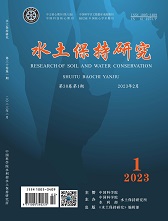[1]GUO Shuo,YANG Weizhou,WEI Minghuan,et al.Cultivated Land Fragmentation and Impact Factors of Qinglong Manchu Autonomous County Based on Geographically Weighted Regression[J].Research of Soil and Water Conservation,2017,24(03):264-269.
Copy
Cultivated Land Fragmentation and Impact Factors of Qinglong Manchu Autonomous County Based on Geographically Weighted Regression
Research of Soil and Water Conservation[ISSN 1005-3409/CN 61-1272/P] Volume:
24
Number of periods:
2017 03
Page number:
264-269
Column:
Public date:
2017-06-28
- Title:
- Cultivated Land Fragmentation and Impact Factors of Qinglong Manchu Autonomous County Based on Geographically Weighted Regression
- Keywords:
- cultivated land; fragmentation; influence factor; geographically weighted regression; Qinglong Manchu Autonomous County
- CLC:
- F301.24
- DOI:
- -
- Abstract:
- We took Qinglong Manchu Autonomous County as an example, based on the relevant theories of landscape ecology, and selected four indicators especially from average area size of plot, regulation degree of plot shape and land distribution: average land area, boundary density, the area-weighted mean shape index and the degree of aggregation. We made measurement and classification on cultivated land fragmentation degree of research area and analyzed the spatial relationship between land fragmentation comprehensive index and gradient, distance to the villages, distance to the rivers, and distance to the roads by means of geographically weighted regression model. The results showed that land fragmentation degree of the Qinglong Manchu Autonomous County of focused on moderate fragmentation and severe fragmentation, accounting for 45.18% and 49.19%, respectively. And there was a negative correlation relationship between the distance to villages as well as roads and land fragmentation degree. On the contrary, the relationship between gradient, the distance to rivers and land fragmentation degree presented positive correlation. The influence extent of each influence factor showed the remarkable spatial non-stability with large fluctuation in the space. The conclusion of this study has a certain reference value for the scaled operation of cultivated land and the improvement of land use efficiency.
- References:
-
[1] 邓建波.耕地细碎化成因及其与生产效率的关系[D].成都:四川农业大学,2013.
[2] 陈春苗.焦作市耕地细碎化测度及其效应分析[D].河南焦作:河南理工大学,2012.
[3] 王道骏,陈英,贾首杰,等.基于景观格局指数的耕地细碎化研究[J].中国农学通报,2014,30(32):184-188.
[4] 谭淑豪,曲福田,尼克,等.土地细碎化的成因及其影响因素分析[J].中国农村观察,2003(6):24-30.
[5] 白志远,陈英,谢保鹏,等.ARCGIS支持下的景观细碎化与耕地利用效率关系研究:以甘肃省康乐县为例[J].干旱区资源与环境,2014,28(4):42-47.
[6] 李鑫,欧名豪,肖长江,等.基于景观指数的细碎化对耕地生产效率影响研究[J].长江流域资源与环境,2012,21(6):707-713.
[7] 吕晓,黄贤金,钟太洋,等.中国农地细碎化问题研究进展[J].自然资源学报,2011,26(3):530-540.
[8] 周静,吴志峰,李定强,等.珠江口两岸耕地景观破碎化定量分析[J].热带地理,2005,25(2):107-110,122.
[9] 赵锐锋,姜朋辉,赵海莉,等.黑河中游湿地景观破碎化过程及其驱动力分析[J].生态学报,2013,33(14):4436-4449.
[10] 陈红宇,朱道林,郧文聚,等.嘉兴市耕地细碎化和空间集聚格局分析[J].农业工程学报,2012,28(4):235-242.
[11] 廖红强,邱勇,杨侠,等.对应用层次分析法确定权重系数的探讨[J].机械工程师,2012(6):22-25.
[12] 武增海,李涛.高新技术开发区综合绩效空间分布研究:基于自然断点法的分析[J].统计与信息论坛,2013,28(3):82-88.
[13] 庞瑞秋,腾飞,魏冶.基于地理加权回归的吉林省人口城镇化动力机制分析[J].地理科学,2014,34(10):1210-1217.
[14] 马瑛.基于地理加权回归模型的农用地地价空间结构研究[D].武汉:华中农业大学,2012.
[15] 刘世梁,刘琦,王聪,等.基于地理加权回归的漫湾库区景观破碎化及影响因子分析[J].地理科学,2014,34(7):856-862.
[16] 李庆东,王秋兵,钱凤魁,等.农户耕地经营细碎化分析:以辽宁省昌图县为例[J].广东农业科学,2010,37(6):230-232.
- Similar References:
Memo
-
Last Update:
1900-01-01
